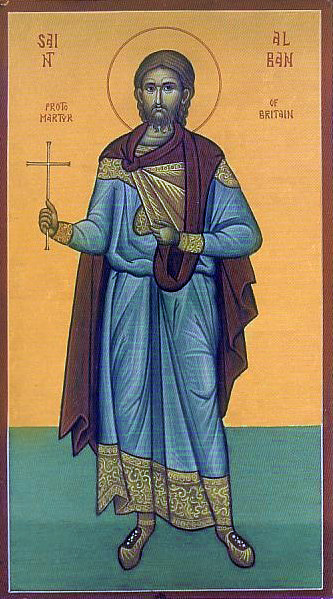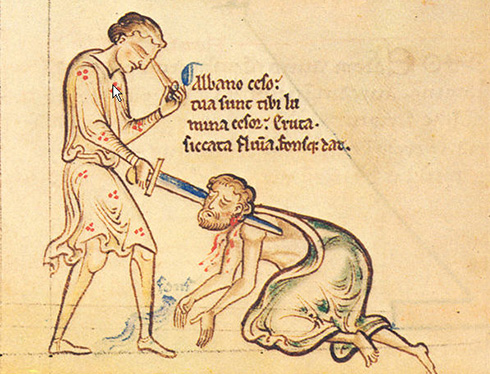Solstices, saints and severed heads
In a previous article the placement of St John’s day at the summer solstice and Jesus birth at the winter solstice was contrasted, see article. Another saint’s day placed at the summer solstice is that of St Alban who is celebrated on 22nd June.

This is the date of his death according to early tradition in St Albans where a shrine grew up that became one of Britain’s major pilgrimage sites. We don’t know exactly when St Alban died so the date is arbitrary. Is there anything to suggest St Alban’s death was associated with the summer solstice? Two details of the story of his martyrdom suggest there may be. St Alban was beheaded and where his head fell a healing spring sprang up. His head was also said to have been placed in a holly bush. Severed saints heads and healing wells emerge in other stories – notably that of St Winifred, or to give her proper Welsh name, Gwenffrewi. She was beheaded by a suitor called Carradog she rejected because she wanted to become a nun. A healing spring sprang up on the site, the place being today’s Holywell in north Wales. In this story her uncle St Beuno used the waters to replace her head and restore her to life. Another saint with a severed head and a healing well is Pembrokshire’s St Teilo who had a healing well in which his skull was kept lined in silver from which the waters were drunk. The skull is to be found today in Lladnaff cathedral, Cardiff.

Later legend drawing on earlier Celtic sources also give us a beheading story with strong seasonal overtones at the winter solstice; sir Gawain and the Green Knight. The mysterious knight comes at New Year to Arthur’s court and challenges any knight who is brave enough to cut off his head. Gawain accepts the challenge and cuts off the knight’s head, only for him to pick it up and put it back on. Gawain as his part of the deal has to be at the knights Green Chapel a year and a day later when he will lose his head. Gawain’s journey the next year begins at Halloween and leads him to a castle on Christmas eve where he undergoes tests that ultimately lead to his being saved from death at the Green Chapel. The story may well be worth returning to, full as it is of seasonal undercurrents. So might the winter solstice beheading link to Alban’s summer solstice beheading? The holly bush may be the clue. It seems likely that in ancient tradition there was a representation of the solstices in the tale of the Holly King and the Oak King. The Holly King was said to rule from the summer to the winter solstice when he was slain and replaced by the Oak King who ruled until it was the Holy King’s turn again next summer solstice. This may explain why St Alban’s head was associated with a holly bush. The holly of course also being taken as a symbol of Christ death yet as part of the Christmas celebration, that is at the winter solstice when the Holly King was slain. St Alban then is symbolically the Oak King slain by the Holly King at the summer solstice. The Green Knight’s appearance is indeed very much like that of the Holly King from mummers plays that kept the story alive.

Alban had been a pagan Roman converted by a travelling missionary in the 3rd century before Constantine had bought the Christian faith acceptance in the Empire. He died in the missionary’s place having put on his cloak to fool the soldiers. At his trial he is said to have refused to offer worship to the Roman gods declaring ‘I worship and adore the true and living God who created all things’. What is interesting here is that his declaration is like the preaching of St Paul in Acts. Faced with trying to explain the Christian faith to Greek and Roman Pagans who knew nothing of the Jewish tradition, he points to nature and the idea of the one true God who created it. Like many tales of early saints the story of Alban shows the move from the many gods to the Christian Trinitarian creator. Yet in the story St Alban also takes up the nature themes of the solstice and the wheel of the year, becoming the Oak King whose death gives life springing up from the land in a sacred well.
Steve Hollinghurst June 2013
Please bookmark this post at Facebook or Twitter:


Your comments:

Pleasley Forest Church
Encountering the Eternal One within the ancient boundaries of Sherwood Forest More ...

Essex Forest Church
We seek to find the presence of God in the open air and in nature, and to connect with the Divine Being who is present in creation. We seek to foster a love of creation, a love which will lead us to care for it. We look for reconciliation between nature and human beings, and within human relationships. More ...
oxforddiocese:
Great to see how @RiponCuddesdon are engaging with @ARochaUK Eco Church scheme - love the Forest Church area made b… twitter.com/i/web/status/1…
18 Aug 22
YBS_Church:
Our Forest Church takes place on Sunday, 28th August, at 4.30pm in the Gifford Community Woodland (Fawn Wood), for… twitter.com/i/web/status/1…
19 Aug 22
rebeccaBug:
Tremeirchion have their first Forest Church service tomorrow so the boys thought they had better check out that the… twitter.com/i/web/status/1…
20 Aug 22
